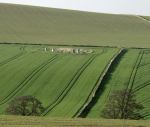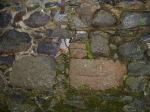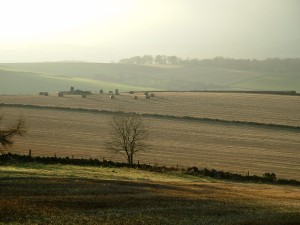2006 Lammas Newsletter Vol.xvii #2 August, 2006
The Lunar Wobble
Orkney, Shetland and Lapland watchers are even more deprived, as the earth’s satellite barely shows her face at full above the southern horizon. This, its wildest fluctuation in the 18.6-year Metonic cycle, will continue into the autumn months. However by winter solstice we shall once again have a companion in full visibility in the night skies.
Think of it this way: in the darkest days of December, the sun at our latitude rises in the south-east and sets in the south-south-west, barely grazing the tops of some of our frostly hills.
This summer, the full moon has been doing just that: rising qnd setting (on full moon night and a couple of nights on either side) in roughly those same compass points, reflecting in amazing precision the path of our solar partner.
That is a simplification. It means if we aren’t looking in the right place, chances are we’ll miss it. It is more precise to say that on October 22, 2005, the moon was closest to full (71%) while standing at its most northerly position in our skies for 18.6 years.
By definition, quarter moons stand at the most northerly point in the sky.
For an exact calculation, check Victor Reijs and our FOGS moon standstill posting, immediately below. There is a discussion group at Archaeocosmology.
Many archaeoastronomers believe that some cupmarks on NE Scots recumbent stone circles mark the maximum moonset for this cycle. If so, then the circle-builders’ technology predated Meton (432BC) by some 3000 years.
Those of us planning to attend FOGS’ 2006 AGM at Cothiemuir on September 16th will be able to check for ourselves as the large recumbent there displqys a cluster of cupmarks on its face with a view angled farthest to the SSW — the most extreme viewing position possible from within the circle. Cothiemuir, NJ617 198, is accessed from My Lord’s Throat, and is one of the earliest of the NE’s RSCs. Contemporary neighboring Old Keig has the largest recorded recumbent stone, weighing in at 53 tons.
©2006-2012MCYoungblood
Message in a Bottle: Crichie Past

Beaker grave cremation pot and horn spoon found in 1855 by Dalrymple at Port Elphinstone henge, 'Druidsfield', Broomend of Crichie
The glass was inscribed with the names of antiqurian Charles Elphinstone Dalrymple, his two colleagues and the local farmer of Broomend, with the date of their excavation, November 22, 1855. Victorian antiquarians frequently left small tokens for their successors to find.
Dalrymple’s family owned Logie, near Pitcaple; sometimes called Logie-Elphinstone. The Port Elphinstone excavation was one of his favourites and showed most detail: including the avenue of 72 megaliths stretching between Crichie and Tavelty, Kintore. Only two of these avenue stones remain.
Another feature now lost to the Reading team which Dalrymple was fortunate to find and record was a triple-ring circle a few metres north of the Druidsfield henge — now forming basement and foundations of a Port Elphinstone housing development. It is hoped the Reading team’s interest in the Kintore corridor will help protect it from further blanket development. The corridor sadly runs parallel with the A96 dual carriageway between Thainstone Mart and the Kintore Industrial Estate. ©MCN
Aberdeen Pictish Conference

Pictish eagle fragment found on Tullo Hill at Forgue-- DES 1999:9 first Pictish eagle-stone to be discovered in the 'Kingdom'
Lloyd Laing, Simon Taylor, David Dumville, Gordon Noble, Nicolas Evans, Strat Halliday, Andrew Heald and Mike King. It is refreshing to see work continuing in the NE where Pictish fragments continue to be found, viz. Forgue eagle-stone, left (DES 1999:9) and a ‘creature’ found in a garden wall at Rothiemay (DES 2002:11). More information available from the Institute, Kings College, University of Aberdeen.
DES = Discovery and Excavation Scotland, whose online documentation of earlier DES publications has reached 2008.
daVinci Sparks Interest in Rosslyn
Rosslyn Chapel, south of Edinburgh, has traditionally attracted the specialist visitor interested in its alleged connection with the Knights Templar and the Holy Grail. Following the release of Dan Brown’s ‘daVinci Code’, visitor numbers have tripled.

Rosslyn's 15thC barrel-vaulted ceiling divided into five compartments. The crypt has Templar carvings.
The chapel was begun in 1446 at around the same time as work started on Glasgow Cathedral. It is one of the few remaining intact pre-Reformation chapels left in Scotland. It towers over the edge of Rosslyn Glen, whose layers of sand, gravel and clay have posed subsidence problems in the past. One exit from the crypt opens on to a gravel bed.
AOC Archaeology Scotland have been employed to create a laser scan record of both interior and exterior; they hope to avoid pitfalls encountered in photography, where a substantial exterior scaffolding canopy –needed for the work– masked several unique features. Scanning has resulted in remarkable three-dimensional and 2D images of the building and its extravagant architectural idiom. This includes the lavishly-decorated interior with its now-famous ‘apprentice pillar’. It is the first full high-precision record to be made on the site and will prove invaluable for research, conservation and for future generations to refer to as a baseline for the building as it now stands.
It is hoped many of the scanned images will be made available on the web.
©FOGS 2006-2012































Recent Comments